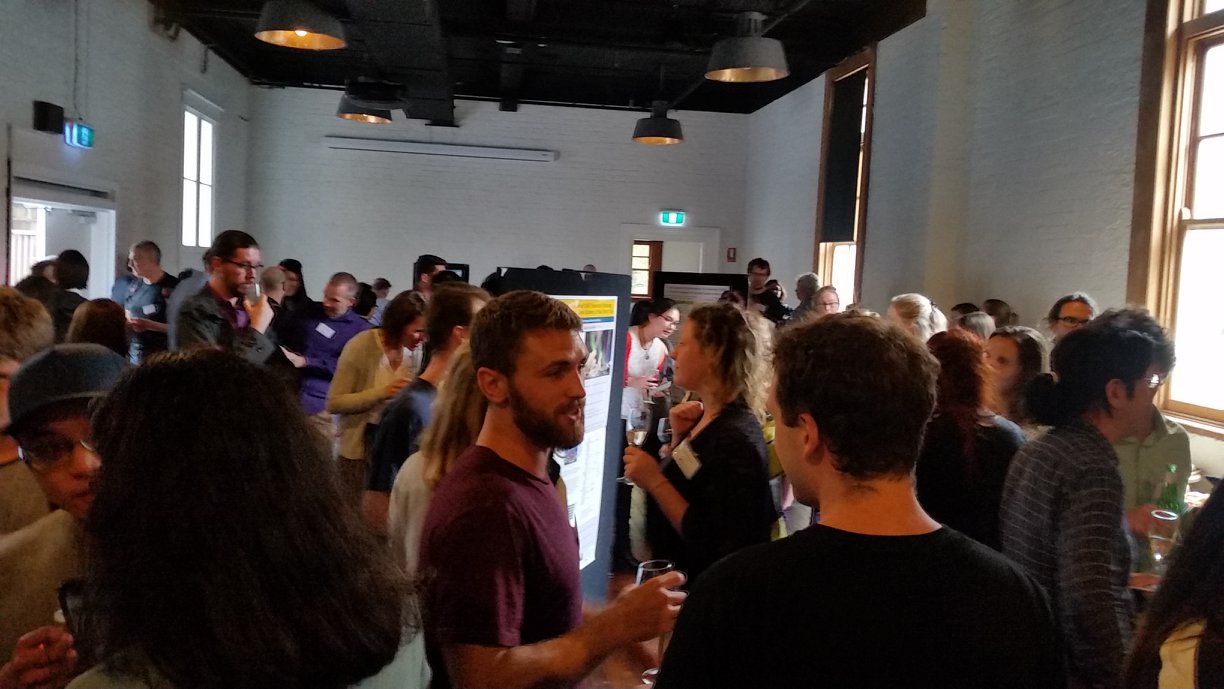By Dr Carly Rosewarne
Originally posted on microbialme.com/blog
The 7th Annual Joint Academic Microbiology Seminars Symposium, or JAMS Symposium for short, is an event I had been looking forward to for quite some time. Held each year in Sydney, it brings together a group of like-minded researchers for a program jam packed with talks and posters covering the latest discoveries in microbiology. And no, I won’t apologise for the pun, because frivolity is mandatory at JAMS. It’s one of the reasons why I like it so much.
This year’s event took place on Wednesday 21st March. After heading to the wrong location (important: read the instructions and don’t just turn up where it was held last time!) I made it to the lecture theatre in the Australian Museum with a few minutes to spare. Just enough time to say a quick hello to Federico Lauro and have my first laugh of many for the day – at his socks, which speak the truth for most meetings but on this occasion they were proclaiming a loud and categorical lie about the afternoon and evening ahead.
Fede opened the show with a quick run-down of the history of JAMS. For the uninitiated, check out my blog post from last time around. This year, a new acronym had emerged, with #MAMGA (Make Australian Microbiology Great Again) decreed as the most important order of business for the day. Like all the other recovering #JAMSaholics in attendance, I was not disappointed. The future of Australian microbiology is in good hands, with Yolanda Plowman from the University of Sydney leading by example as our enthusiastic MC.
First cab off the rank was Mike Manefield from UNSW. Given his involvement with JAMS from the beginning and his passion for all things microbiology, it came as no surprise to me that his talk was both whimsical and comprehensive. Mike covered a lot of ground in a short space of time, including highlights from Matthew Lee’s work on microbial organohalide respiration for bioremediation of sediment in the nearby Botany Bay, through to Sabrina Beckmann’s project using neutral red to enhance methane production by Methanosarcina. It’s fair to say that Sabrina’s presence was sorely missed at JAMS7, but her legacy most definitely lives on. It was great to have her chiming in on the fun via Twitter – in real time, all the way from Delaware!
Next up was Caroline Chénard from Nanyang Technological University in Singapore, the first of two international speakers. Caroline talked about her research on the effects of nutrient availability on marine viral communities in the Singapore and Johor Straits, which she has studied using a hybrid Illumina/Nanopore sequencing approach. The audience particularly enjoyed Caroline’s enthusiastic efforts to highlight of the importance of viruses as a globally dominant biological entity!
The final science talk before the much anticipated poster session was delivered by Chris Greening from Monash University. With a nod to a favourite late night pub anthem, he explained how some microbes are (whoa!) living on the air by scavenging atmospheric gases in order to survive. It never ceases to amaze me how gosh-darn clever microbes are! Some great collaborative research spanning several Australian labs was necessary to bring these discoveries to light.
Next, in a display of what can only be described as shameless self-promotion, I was lucky enough to take to the stage before the break for a rapid-fire introduction to the EMCR Forum and my role on the Executive team. For the uninitiated, the mission of the EMCR Forum is to serve as the voice of Australia’s early- and mid-career researchers, championing improvement in the national research environment through advocacy. The focus of the Forum is on sustainable and transparent career structures, diversity and inclusion, stable funding policies, professional development opportunities, and raising awareness of issues facing the future of science. Membership of the EMCR Forum is 100% free and open to all researchers within 15 years post-PhD. If you’re an EMCR reading this and you haven’t signed up yet, what are you waiting for? I strongly advise you to do it right now!
I quickly found out that few things in life are free, and was asked to repay the organising committee for letting me speak about the EMCR Forum by helping to judge the PhD student poster session with Belinda Ferrari from UNSW and Lisa Moore from Macquarie University. I’m joking of course – it was an honour to be asked to make such an important decision. It was uplifting to feel the energy in the room as I hung back to watch the students interact with other scientists and talk about their research. It was genuinely challenging to pick a winner for the Jeff Powell perpetual student award, so named in honour of Jeff’s gaffe at JAMS1 when he entered a poster and temporarily “won” the competition – before he was disqualified for being a postdoc! The announcement was made later in the evening, but I won’t keep you in suspense – the prize went to Vanessa Pirotta from Macquarie University for her poster describing the use of drones to collect microbes from whale snot.
The slot after the poster break at the JAMS annual symposium is traditionally the hardest – mostly because the delegates are full of cheese and wine or beer which can mess with our ability to focus properly! Luckily Talitha Santini from UQ was up to the challenge. It was inspiring to hear her talk so passionately about her research in the traditionally male dominated mining sector, and learn about how microbial communities are being engineered to bioremediate abandoned sites. For me, this was a definite highlight of the JAMS7 program.

